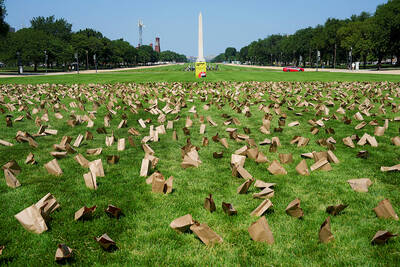Taiwan’s gross domestic expenditure on research and development (R&D) is ranked third-highest in the world as it reached 3.36 percent of total gross domestic product, or NT$616 billion (US$20.55 billion), in 2018, the Ministry of Economic Affairs Department of Statistics said in a report yesterday.
That surpassed Japan’s 3.26 percent, the US’ 2.83 percent and China’s 2.19 percent. Taiwan’s gross domestic expenditure on R&D closely followed Israel’s and South Korea’s, which remained the top two spenders on R&D at 4.9 percent and 4.53 percent respectively in 2018.
Corporate spending has become the main driving force behind Taiwan’s gross domestic expenditure on R&D, making up 80.3 percent of total expenditure, on a level with that of South Korea, ministry data showed.
Japan, China and the US posted slightly lower figures at 79.4 percent, 77.4 percent and 72.6 percent respectively.
The ministry data also showed that Taiwan’s spending on R&D is concentrated on technical development, which increased 8.2 percent from 2017 to make up 69.7 percent of total expenditure in 2018.
Corporate spending was highest in the manufacturing sector, namely the computer, electronics and optical components industry, which made up 73.6 percent of total corporate expenditure on R&D in 2018.
By comparison, South Korean firms in this industry made up only about 51.9 percent of total R&D expenditure, while in Japan and China, it only made up 19.5 percent and 16.2 percent respectively.
Taiwanese companies’ R&D spending in the service sector only made up 8.2 percent of total corporate expenditure on R&D.
Meanwhile, Taiwan’s spending on basic research declined by 3.6 percentage points over the same period, making up only 7.3 percent of total expenditure.
This is mainly due to budget cuts in government spending, as well as in higher education, the report said.
However, Taiwan’s spending on applied research increased 8 percentage points from 2017 to 2018, contributing 23 percent of total expenditure.

Nvidia Corp chief executive officer Jensen Huang (黃仁勳) on Monday introduced the company’s latest supercomputer platform, featuring six new chips made by Taiwan Semiconductor Manufacturing Co (TSMC, 台積電), saying that it is now “in full production.” “If Vera Rubin is going to be in time for this year, it must be in production by now, and so, today I can tell you that Vera Rubin is in full production,” Huang said during his keynote speech at CES in Las Vegas. The rollout of six concurrent chips for Vera Rubin — the company’s next-generation artificial intelligence (AI) computing platform — marks a strategic

Enhanced tax credits that have helped reduce the cost of health insurance for the vast majority of US Affordable Care Act enrollees expired on Jan.1, cementing higher health costs for millions of Americans at the start of the new year. Democrats forced a 43-day US government shutdown over the issue. Moderate Republicans called for a solution to save their political aspirations this year. US President Donald Trump floated a way out, only to back off after conservative backlash. In the end, no one’s efforts were enough to save the subsidies before their expiration date. A US House of Representatives vote

REVENUE PERFORMANCE: Cloud and network products, and electronic components saw strong increases, while smart consumer electronics and computing products fell Hon Hai Precision Industry Co (鴻海精密) yesterday posted 26.51 percent quarterly growth in revenue for last quarter to NT$2.6 trillion (US$82.44 billion), the strongest on record for the period and above expectations, but the company forecast a slight revenue dip this quarter due to seasonal factors. On an annual basis, revenue last quarter grew 22.07 percent, the company said. Analysts on average estimated about NT$2.4 trillion increase. Hon Hai, which assembles servers for Nvidia Corp and iPhones for Apple Inc, is expanding its capacity in the US, adding artificial intelligence (AI) server production in Wisconsin and Texas, where it operates established campuses. This

US President Donald Trump on Friday blocked US photonics firm HieFo Corp’s US$3 million acquisition of assets in New Jersey-based aerospace and defense specialist Emcore Corp, citing national security and China-related concerns. In an order released by the White House, Trump said HieFo was “controlled by a citizen of the People’s Republic of China” and that its 2024 acquisition of Emcore’s businesses led the US president to believe that it might “take action that threatens to impair the national security of the United States.” The order did not name the person or detail Trump’s concerns. “The Transaction is hereby prohibited,”